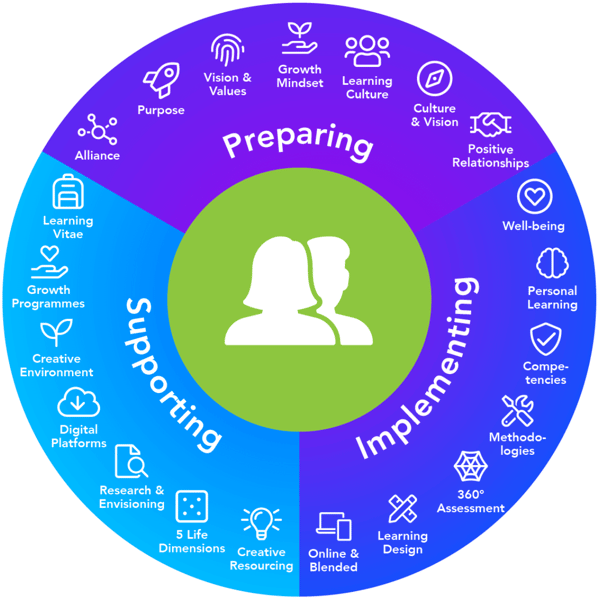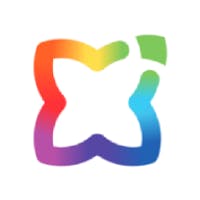What are The Elements of Learning Innovation?
The Elements of Learning Innovation is a living roadmap consisting of aggregated research with particular respect to cognitive neuroscience, psychology and the science of learning. It provides research-based foundations for different communities that are seeking to update existing practices or create a fresh learning model and information to support transformation to a new learning paradigm. It is by no means a ‘one-size-fits-all’ approach and offers a holistic framework for communities to contextualise and grow individual capacities in becoming lifelong learners.
The Elements do not seek to provide an alternative model, but rather a framework for;
- thinking through learning-related topics and research;
- enabling communities to contextualise a new roadmap;
- addressing the complexities of change, and;
- identifying and providing solutions for the challenges of embedding and sustaining change.
The Elements consists of 21 elements divided into 3 clusters. Our roadmap places the individual experience of positive and functional relationships at its core, drawing from Maslow’s hierarchy of needs concept.

Cluster One: Preparing the Community
Cluster 1 provides in-depth information on shaping and growing a healthy learning culture as a prerequisite for change, specifically by nurturing a strong sense of purpose, identity and wellness, all of which have a profound impact on learning and learner development. Positive community culture is also critical and the roadmap directs consistent and recurrent energy to growing this, in both the individual and the whole community.
Cluster Two: Implementing Change
Cluster 2 covers some key aspects of the more academic components of learning:
- How do you weave the different threads of practice together in a manner that can consistently change pedagogic capacity?
- How do you make learning personal to each individual?
- What diverse methodologies might be helpful in establishing a proactive culture and capacity for learning?
- How does an understanding of competencies and skills sit alongside prescribed content?
- What are the possibilities for remote, blended and online learning?
- How might assessment of learning be made meaningful & relevant?
- How might you create learning opportunities that develop learner agency?
An understanding of the various dimensions of our lives requires significant mention. For learners to thrive, they need to have a clear perspective of themselves as a prerequisite to building effective interpersonal relationships. Equally important is the reality that our world is changing at a rapid pace, labelled by some as the VUCA world; volatile, uncertain, complex and ambiguous. This VUCA world is one where fresh opportunity abounds for those able to rise to challenges as creative and collaborative problem-solvers, thriving on connectedness, optimism and lateral thinking.
Cluster Three: Supporting Change
Cluster 3 provides an overview of the significant topics that should take priority to embed and sustain transformation to a new paradigm. This includes consideration of;
- creative ways of resourcing a learning community;
- how space might be used more effectively to support learning;
- continued envisioning to remain relevant in a world of constant change;
- professional development of practitioners to deliver innovative learning practices that embody a new paradigm, and;
- the effective use of technological infrastructure relevant to the contextual needs of a community.
A key challenge in embedding a new paradigm, or in seeking to modify existing approaches, is the ongoing development of staff. People might be well-aligned to a new vision for learning, but if their own training, understanding or experience has been in a more traditional model, then they will need ongoing coaching and support. The roadmap proposes different approaches for developing a cohesive strategy around personal and professional growth.
What does the “school” experience look like?
Any daily experience of learning is built upon a strong foundation of purpose, culture and positive, functional relationships. Learning experiences are designed (or co-created) to cater to whatever the external context might be, including any government mandated curricula and assessment frameworks. But regardless, if the end goal is still to empower self-determined (heutagogy) and lifelong learning, then all activities will have the aim of developing independence and interdependence as learners. The shift is fundamentally from a standardised approach to one that empowers personal learning.
Some key facets of the “school” experience would include:
- creating schedules suited to any context but still consistent with the wider model framework;
- providing for consistent development of core concepts within individuals or teams, and;
- respecting individual disciplines when and where relevant while encouraging trans-disciplinary perspectives.
Watch our learners describe their learning experience at Learnlife.
Measuring learners' progress
Some learning communities which focus on developing individual capacity for lifelong learning may still operate within the constraints of existing and more traditional assessment requirements. If so, such requirements must be met, but do not need to be the end point for presentation of learning. Research demonstrates that the most effective assessment of learning is when it is formative in design, enhanced by comprehensive feedback and where the learner demonstrates agency over the representation of their learning. The Learnlife Learning Vitae (LV) will provide a digital platform with an adaptive dashboard – a portfolio which captures, collates and presents learning progressions in diverse ways suited to any future contexts (e.g. tertiary institutions or prospective employers). The key is offering the learner agency to create, curate and present their own learning in a way that is unique to them.
Connecting to The Elements of Learning Innovation
Learnlife is growing an Alliance for change; a movement that seeks to re-shape, re-imagine and re-create a new (and level) playing field for learning in which healthy, happy learners, and society at large can thrive. Change is possible when we unite, collaborate and co-create as a community.
Over 800 thought leaders, innovators, learning leaders, learning practitioners and passion pushers in the field of education, or related fields of influence who care deeply about the future of learning, from over 80 countries, have joined The Alliance to help co-create and shape a new learning paradigm.
Join our Alliance to collaborate, share, learn, debate, discuss, shape and spread future-focused innovation and help shape a new learning paradigm - it’s free!


